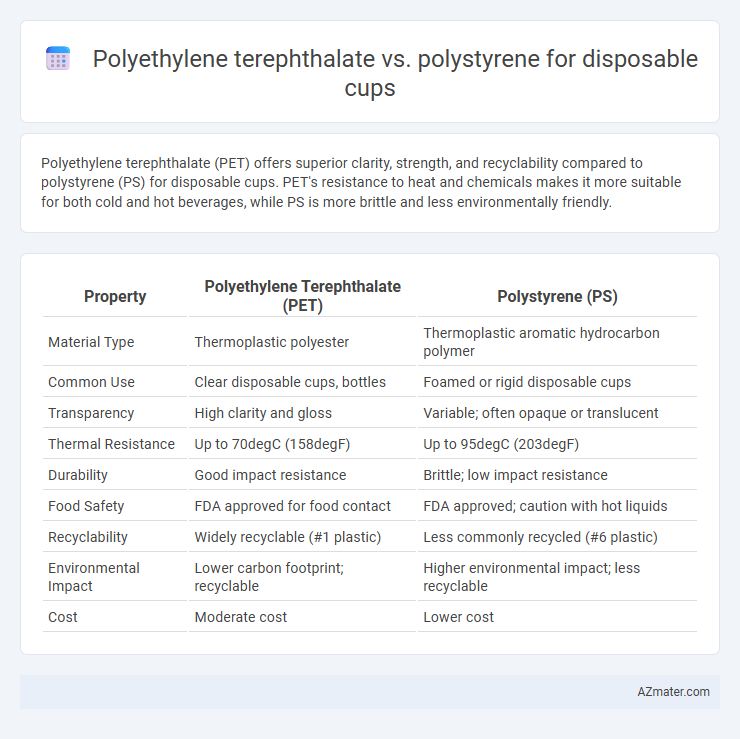Polyethylene terephthalate (PET) offers superior clarity, strength, and recyclability compared to polystyrene (PS) for disposable cups. PET's resistance to heat and chemicals makes it more suitable for both cold and hot beverages, while PS is more brittle and less environmentally friendly.
Table of Comparison
| Property | Polyethylene Terephthalate (PET) | Polystyrene (PS) |
|---|---|---|
| Material Type | Thermoplastic polyester | Thermoplastic aromatic hydrocarbon polymer |
| Common Use | Clear disposable cups, bottles | Foamed or rigid disposable cups |
| Transparency | High clarity and gloss | Variable; often opaque or translucent |
| Thermal Resistance | Up to 70degC (158degF) | Up to 95degC (203degF) |
| Durability | Good impact resistance | Brittle; low impact resistance |
| Food Safety | FDA approved for food contact | FDA approved; caution with hot liquids |
| Recyclability | Widely recyclable (#1 plastic) | Less commonly recycled (#6 plastic) |
| Environmental Impact | Lower carbon footprint; recyclable | Higher environmental impact; less recyclable |
| Cost | Moderate cost | Lower cost |
Introduction to Disposable Cup Materials
Polyethylene terephthalate (PET) and polystyrene (PS) are commonly used materials for disposable cups, each offering distinct properties suited for various beverage needs. PET provides excellent clarity, durability, and is highly recyclable, making it ideal for cold drinks like water and soft beverages. Polystyrene, often found in foam or rigid forms, offers superior insulation and cost-effectiveness but poses challenges in recyclability and environmental impact.
Overview of Polyethylene Terephthalate (PET)
Polyethylene terephthalate (PET) is a thermoplastic polymer widely used in disposable cups due to its excellent clarity, high strength-to-weight ratio, and resistance to moisture and gases. Its chemical structure, composed of repeating ester units derived from terephthalic acid and ethylene glycol, enables superior durability and recyclability compared to polystyrene cups. PET's lightweight yet sturdy nature makes it ideal for single-use applications, offering enhanced sustainability through efficient recycling processes and reduced carbon footprint.
Overview of Polystyrene (PS)
Polystyrene (PS) is a lightweight, rigid plastic commonly used for disposable cups due to its excellent insulation properties and cost-effectiveness. It offers good clarity and ease of molding, making it popular in foodservice applications where temperature retention and presentation are important. However, PS is less environmentally friendly compared to Polyethylene terephthalate (PET) because of its lower recyclability and tendency to release harmful chemicals when improperly disposed.
Physical Properties Comparison: PET vs PS
Polyethylene terephthalate (PET) exhibits higher tensile strength and better impact resistance compared to polystyrene (PS), making PET more durable for disposable cup applications. PET offers greater clarity and chemical resistance, which enhances the visual appeal and suitability for various beverages, while PS tends to be more brittle and less heat resistant. Furthermore, PET's higher melting temperature supports hot beverage use better than PS, which softens at lower temperatures.
Environmental Impact: PET vs PS Cups
Polyethylene terephthalate (PET) cups exhibit higher recyclability compared to polystyrene (PS) cups, contributing to reduced landfill waste and lower environmental pollution. PS cups, often non-biodegradable and challenging to recycle, tend to persist in ecosystems, increasing the risk of microplastic contamination. Life cycle assessments reveal PET cups have a smaller carbon footprint and energy consumption during production and disposal stages than PS cups.
Food Safety and Chemical Migration
Polyethylene terephthalate (PET) offers superior food safety for disposable cups due to its high resistance to chemical migration, reducing the risk of harmful substances leaching into beverages. Polystyrene (PS), while commonly used, poses greater concerns regarding styrene monomer migration, especially with hot or acidic drinks, potentially impacting consumer health. Regulatory agencies such as the FDA and EFSA typically approve PET for a wider range of food contact applications, making it a safer choice for disposable cups in terms of chemical stability and safety compliance.
Thermal Resistance and Beverage Suitability
Polyethylene terephthalate (PET) offers superior thermal resistance compared to polystyrene (PS), maintaining structural integrity at temperatures up to 60degC, making it suitable for both cold and moderately hot beverages. Polystyrene tends to deform or release styrene compounds at elevated temperatures, limiting its use primarily to cold drinks. For disposable cups requiring stability and safety in hot beverage applications, PET stands out as the more reliable and versatile material.
Cost and Manufacturing Efficiency
Polyethylene terephthalate (PET) offers lower production costs and higher manufacturing efficiency compared to polystyrene (PS) due to its superior thermoforming capabilities and faster cycle times in injection molding. PET's recyclability and greater clarity also reduce waste management expenses, making it a cost-effective choice for disposable cups in high-volume applications. Polystyrene tends to incur higher material costs and slower processing speeds, limiting its economic viability in mass production environments.
Recycling and End-of-Life Considerations
Polyethylene terephthalate (PET) is widely favored in disposable cup manufacturing due to its high recyclability and the established infrastructure for its collection and processing, enabling efficient conversion into fibers and new containers. Polystyrene (PS), commonly used for foam cups, presents significant challenges in recycling due to its low density, contamination issues, and limited market demand for recycled material, often resulting in landfilling or incineration. End-of-life considerations prioritize PET over polystyrene for sustainability, as PET's recyclability reduces landfill burden and environmental impact, whereas polystyrene contributes more substantially to waste accumulation and pollution.
Conclusion: Best Choice for Disposable Cups
Polyethylene terephthalate (PET) offers superior clarity, durability, and recyclability compared to polystyrene (PS), making it the best choice for disposable cups. PET's higher impact resistance and resistance to moisture contribute to better performance in various beverage applications. Environmental benefits of PET, including widespread recycling infrastructure, further enhance its suitability over polystyrene in disposable cup production.

Infographic: Polyethylene terephthalate vs Polystyrene for Disposable Cup
 azmater.com
azmater.com